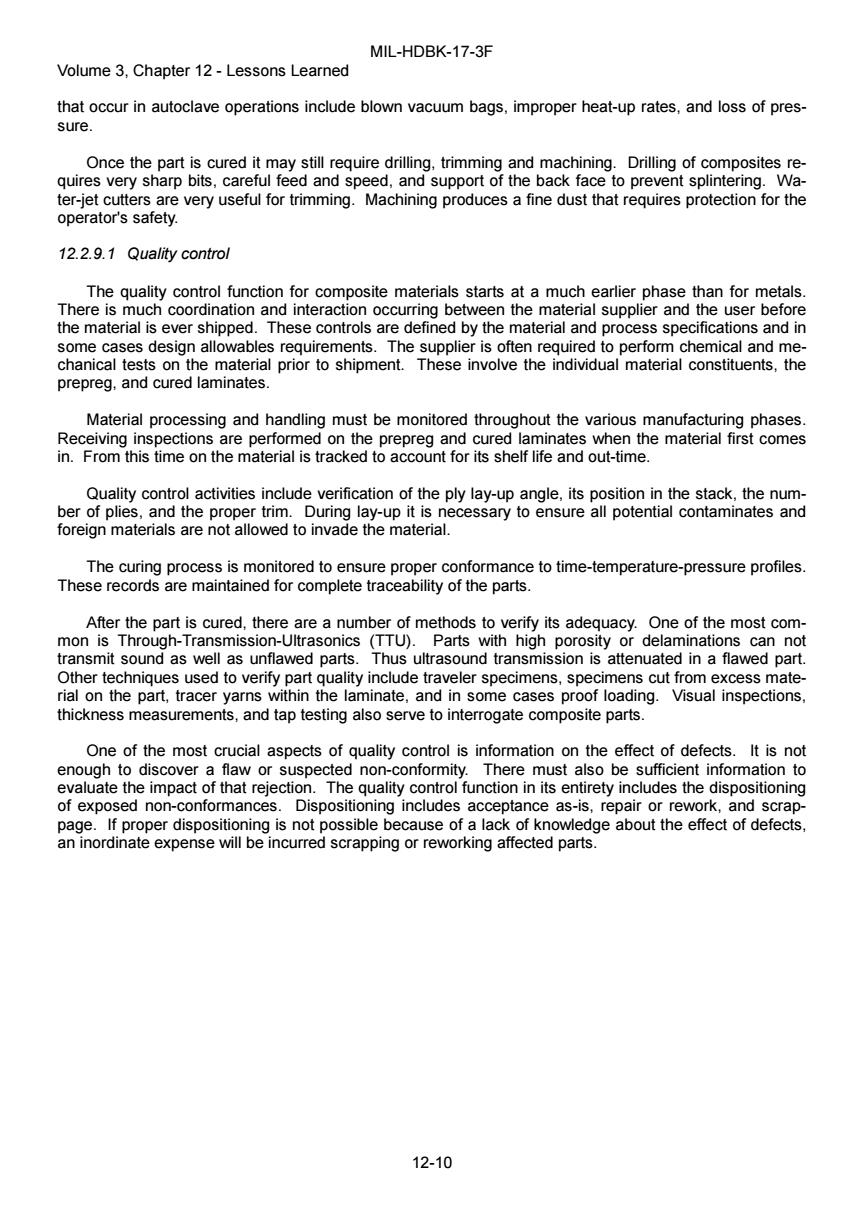正在加载图片...

MIL-HDBK-17-3F Volume 3,Chapter 12-Lessons Learned that occur in autoclave operations include blown vacuum bags,improper heat-up rates,and loss of pres- sure. Once the part is cured it may still require drilling,trimming and machining.Drilling of composites re- quires very sharp bits,careful feed and speed,and support of the back face to prevent splintering.Wa- ter-jet cutters are very useful for trimming.Machining produces a fine dust that requires protection for the operator's safety. 12.2.9.1 Quality control The quality control function for composite materials starts at a much earlier phase than for metals. There is much coordination and interaction occurring between the material supplier and the user before the material is ever shipped.These controls are defined by the material and process specifications and in some cases design allowables requirements.The supplier is often required to perform chemical and me- chanical tests on the material prior to shipment.These involve the individual material constituents,the prepreg,and cured laminates. Material processing and handling must be monitored throughout the various manufacturing phases. Receiving inspections are performed on the prepreg and cured laminates when the material first comes in.From this time on the material is tracked to account for its shelf life and out-time. Quality control activities include verification of the ply lay-up angle,its position in the stack,the num- ber of plies,and the proper trim.During lay-up it is necessary to ensure all potential contaminates and foreign materials are not allowed to invade the material. The curing process is monitored to ensure proper conformance to time-temperature-pressure profiles. These records are maintained for complete traceability of the parts. After the part is cured,there are a number of methods to verify its adequacy.One of the most com- mon is Through-Transmission-Ultrasonics (TTU).Parts with high porosity or delaminations can not transmit sound as well as unflawed parts.Thus ultrasound transmission is attenuated in a flawed part. Other techniques used to verify part quality include traveler specimens,specimens cut from excess mate- rial on the part,tracer yarns within the laminate,and in some cases proof loading.Visual inspections, thickness measurements,and tap testing also serve to interrogate composite parts. One of the most crucial aspects of quality control is information on the effect of defects.It is not enough to discover a flaw or suspected non-conformity.There must also be sufficient information to evaluate the impact of that rejection.The quality control function in its entirety includes the dispositioning of exposed non-conformances.Dispositioning includes acceptance as-is,repair or rework,and scrap- page.If proper dispositioning is not possible because of a lack of knowledge about the effect of defects, an inordinate expense will be incurred scrapping or reworking affected parts. 12-10MIL-HDBK-17-3F Volume 3, Chapter 12 - Lessons Learned 12-10 that occur in autoclave operations include blown vacuum bags, improper heat-up rates, and loss of pressure. Once the part is cured it may still require drilling, trimming and machining. Drilling of composites requires very sharp bits, careful feed and speed, and support of the back face to prevent splintering. Water-jet cutters are very useful for trimming. Machining produces a fine dust that requires protection for the operator's safety. 12.2.9.1 Quality control The quality control function for composite materials starts at a much earlier phase than for metals. There is much coordination and interaction occurring between the material supplier and the user before the material is ever shipped. These controls are defined by the material and process specifications and in some cases design allowables requirements. The supplier is often required to perform chemical and mechanical tests on the material prior to shipment. These involve the individual material constituents, the prepreg, and cured laminates. Material processing and handling must be monitored throughout the various manufacturing phases. Receiving inspections are performed on the prepreg and cured laminates when the material first comes in. From this time on the material is tracked to account for its shelf life and out-time. Quality control activities include verification of the ply lay-up angle, its position in the stack, the number of plies, and the proper trim. During lay-up it is necessary to ensure all potential contaminates and foreign materials are not allowed to invade the material. The curing process is monitored to ensure proper conformance to time-temperature-pressure profiles. These records are maintained for complete traceability of the parts. After the part is cured, there are a number of methods to verify its adequacy. One of the most common is Through-Transmission-Ultrasonics (TTU). Parts with high porosity or delaminations can not transmit sound as well as unflawed parts. Thus ultrasound transmission is attenuated in a flawed part. Other techniques used to verify part quality include traveler specimens, specimens cut from excess material on the part, tracer yarns within the laminate, and in some cases proof loading. Visual inspections, thickness measurements, and tap testing also serve to interrogate composite parts. One of the most crucial aspects of quality control is information on the effect of defects. It is not enough to discover a flaw or suspected non-conformity. There must also be sufficient information to evaluate the impact of that rejection. The quality control function in its entirety includes the dispositioning of exposed non-conformances. Dispositioning includes acceptance as-is, repair or rework, and scrappage. If proper dispositioning is not possible because of a lack of knowledge about the effect of defects, an inordinate expense will be incurred scrapping or reworking affected parts